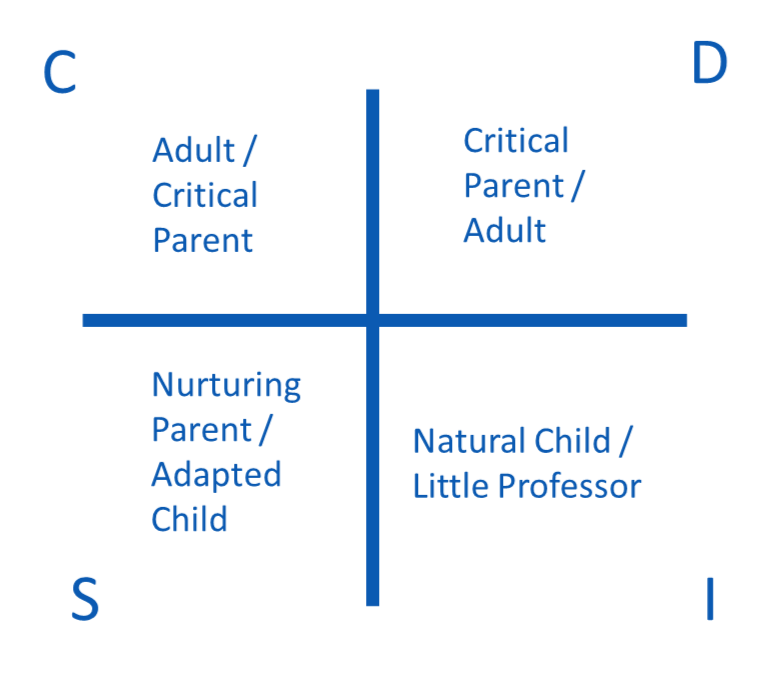Understanding how each DISC style likes to give and receive information helps us communicate more effectively.
By laying the filter of Transactional Analysis over DISC we can identify potential communication conflicts and better manage our expectations for an interaction with a friend, partner, colleague or employee.

The theory of transactional analysis, first put forward by Professor Eric Byrne, states that all humans have three tape recorders or “ego states” instead us – the parent, the adult and the child. The parent and child tape recorders are split into two and three sub-ego states respectively. The parent has a “critical” side and a “nurturing” side and the child has an “adapted” (compliant) side a “natural” (playful/fearful) side and a “Little Professor/rebellious” (mischievous/angry) side. The adult ego state is a computer that takes in and sorts information.
Because of their preference for achievement, and difficulty understanding those that can’t or won’t achieve like they do, Ds tend to communicate from their Critical Parent ego state, which sounds like, “you should do this” or “I can’t believe you didn’t do <blank>.” As D-dominant individuals also prefer to communicate through high-level facts (e.g. “revenue was up 14% last quarter), they will also communicate from their Adult ego state.
With an Is preference to communicate in a fun, upbeat and happy way they tend to communicate from their Natural Child ego state, which sounds like “this will be SO much fun” or “hey guys, I’ve got a GREAT idea for a team building event.” When an I-dominant feels like they aren’t getting their communication needs met they will switch into Little Professor to get their needs met by playing games (e.g. “well, I’d love to help you with that project, but I’ve got so much to do.”
As they tend to be the most nurturing communicators of the four DISC styles, S-dominants’s default ego state is the Nurturing Parent. Because Ss fear disharmony in their group they will fall into the Adapted (compliant) Child ego state if they sense that going along with the crowd will keep their group together.
The most computer like communicators, the Cs communicate from the most computer like ego state, the Adult. C-dominants will switch into Critical Parent communication when they want to prove how smart they are or when they get frustrated with an individual who “doesn’t get it.”
From the figure above you can see that each DISC style’s preferred ego state for communication can create complementary communication and result in communication conflict.
- Ds communicating with Cs – potentially complimentary as their preferred ego states (Adult and Critical Parent) are reversed; however, conflict will arise when the C-dominant who is communicating from their Adult attempts to communicate more detail than the D-dominant who is communication from their Critical Parent than the D-dominant wants to hear.
- Ds communicating with Is – potentially complimentary as you have a Parent (the D-dominant) communicating to a Child (I-dominant), especially if the Critical Parent “D” accesses the fear side of the Natural Child “I” (e.g. “do it or you’re fired.”).Plenty of room for conflict as the I-dominant’s Little Professor plays games with the D-dominant’s Critical Parent (e.g. “let ‘em try to fire me. They’ll find out how valuable I really am.”)
- Is communicating with Ss – potentially complimentary with a Parent (S-dominant) communicating to a Child (I-dominant) because the Nurturing Parent “S” will let the Natural Child “I” get away with more than a C- or D-dominant would. Conflicts between Is and Ss will happen when the I-dominant’s Little Professor attempts to get the S-dominant’s Adapted Child involved in a mischievous game, which triggers the S-dominant’s Parent to shut down the game and hurt the I-dominant’s feelings
- Ss communicating with Cs – potentially complimentary as the S’s Nurturing Parent will listen to the C’s Adult and the S’s Adapted Child will respond to the C’s Adult or Critical Parent. Conflict would arise when the C-dominant’s Critical Parent attempts to influence the S-dominant’s Adapted Child, which triggers the S’s Parent to Step in.
- Ds communicating with Ss – while both have a Parent as their dominant ego state, because the D’s is Critical and the S’s is Nurturing, Ds will tend to get frustrated with Ss who they perceive as being “coddling.” If a D-dominant’s Critical Parent can trigger an S-dominant’s Adapted Child conflict may be replaced with compliance for a little while before the S’s Parent attempts to assert themselves.
- Is communicating with Cs – little room for complimentary communication as the C’s Adult and I’s Natural Child are focused on different triggers (data and emotions respectively). Lots of room for conflict as the C-dominant’s Critical Parent will lash out at the I-dominant’s Natural Child, which will send the “I” into their Little Professor where they will seek to “get” the Critical Parent who hurt them.
Don’t take the DISC/TA tie-in as an absolute. An individual’s preferred ego state has a lot to do with their first six years of life when their Parent and Child tapes are running. For example, I am D-dominant, but my preferred ego state is Nurturing Parent because I had an incredibly nurturing mother.
Also don’t use this information to analyze the person with which you’re speaking while in the middle of your conversation. We have a choice to either “react” or “respond” to a communication from another person. If you are reacting you’re likely communicating from your Critical Parent or Child ego state. If you are responding you typically communicate from your Adult or Nurturing Parent.
Understanding your preferred ego states will help you in responding instead of reacting.
